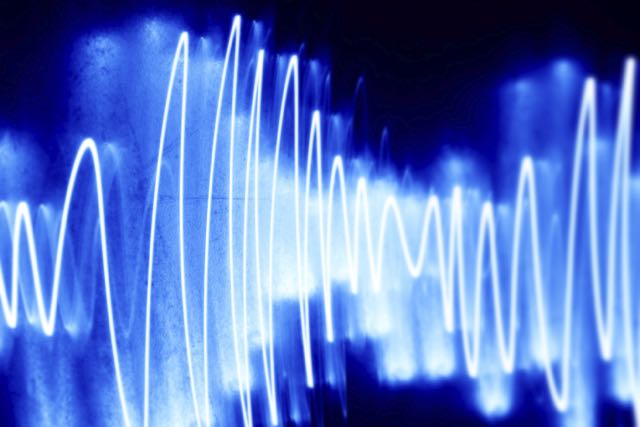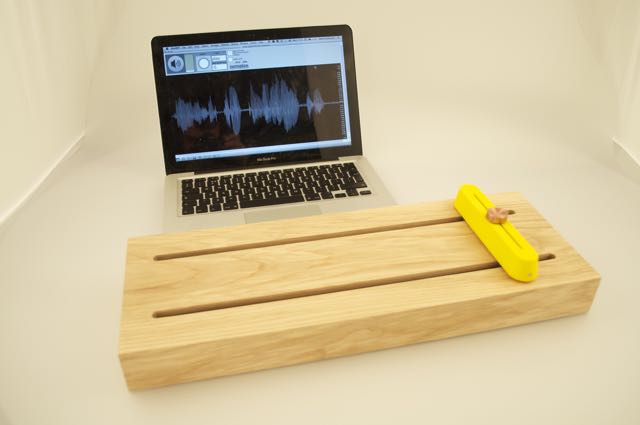A magazine where the digital world meets the real world.
On the web
- Home
- Browse by date
- Browse by topic
- Enter the maze
- Follow our blog
- Follow us on Twitter
- Resources for teachers
- Subscribe
In print
What is cs4fn?
- About us
- Contact us
- Partners
- Privacy and cookies
- Copyright and contributions
- Links to other fun sites
- Complete our questionnaire, give us feedback
Search:
Blind driver filches funky feely sound machine! The Haptic Wave
by Jane Waite, Queen Mary University of London

The blind musician Joey Stuckey in his recent music video commandeers then drives off in a car, and yes he is blind. How can a blind person drive a car, and what has that got to do with him trying to filch a sound machine? So maybe taking the car was just a stunt, but he really did try and run off with a novel sound machine!
As well as fronting his band Joey is an audio engineer. Unlike driving a car, which is all about seeing things around you - signs, cars pedestrians - being an audio engineer seems a natural job for someone who is blind. Its about recording, mixing and editing music, speech and sound effects. What matters most is that the person has a good ear. Having the right skills could easily lead to a job in the music industry, in TV and films, or even in the games industry. It's also an important job. Getting the sound right is critical to the experience of a film or game. You don't want to be struggling to hear mumbling actors, or the sound effects to drown out a key piece of information in a game.
Mixing desks
Once upon a time Audio engineers used massive physical mixing desks. That was largely ok for a blind person as they could remember the positions of the controls as well as feel the buttons. As the digital age has marched on, mixing desks have been replaced by Digital Audio Workstations. They are computer programs and the trouble is that despite being about sound, they are based on vision.
When we learn about sound we are shown pictures of wavy lines: sound waves. Later, we might use an oscilloscope or music editing software, and see how, if we make a louder sound, the curves get taller on the screen: the amplitude. We get to hear the sound and see the sound wave at the same time. That's this multimodal idea again, two ways of sensing the same thing.
But hang on, sound isn't really a load of wavy lines curling out of our mouths, and shooting away from guitar strings. Sound is energy and atoms pushing up against each other. But we think of sound as a sound wave to help us understand it. That's what a computer scientist calls abstraction: representing things in a simpler way. Sound waves are an abstraction, a simplified representation, of sound itself.
The representation of sound as sound waves, as a waveform, helps us work with sound, and with Digital Audio Workstations it is now essential for audio engineers. The engineer works with lines, colors, blinks and particularly sound waves on a screen as they listen to the sound. They can see the peaks and troughs of the waves, helping them find the quiet, loud and distinctive moments of a piece of music, at a glance, for example. That's great as it makes the job much easier...but only if you are fully sighted. It makes things impossible for someone with a visual impairment. You can't see the sound waves on the editing screen. Touching a screen tells you nothing. Even though it's ultimately about sounds, doing your job has been made as hard as driving a car. This is rather sad given computers have the potential to make many kinds of work much more accessible to all.
Feel the sound

The DePIC research team, a group of people from Goldsmiths, Queen Mary University of London and Bath Universities with a mission to solve problems that involve the senses, decided to fix it. They've created the first ever plug-in software for professional Digital Audio Workstations that makes peak level meters completely accessible. It uses 'sonification': it turns those visual signals in to sound! decided to fix the problems. They brought together Computer Scientists, Design experts, and Cognitive Scientists and most importantly of all audio engineers who have visual impairments. Working together over two years in workshops sharing their experiences and ideas, developing, testing and improving prototypes to figure out how a visually impaired engineer might 'see' soundwaves. They created the HapticWave, a device that enables a user to feel rather than see a sound wave.
The HapticWave
The HapticWave combines novel hardware and software to provide a new interface to the traditional Digital Audio Workstation. The hardware includes a long wooden box with a plastic slider. As you move the slider right and left you move forward and backwards through the music. On the slider there is a small brass button, called a fader. Tiny embossed stripes on the side of the slider let you know where the fader is relative to the middle and ends of the slider. It moves up and down in sync with the height of the sound wave. So in a quiet moment the fader returns to the centre of the slider. When the music is loud, the fader zooms to the top of the handle. As you slide forwards and backwards through the music the little button shoots up and down, up and down tracing the waveform. You feel its volume changing. Music with heavy banging beats has your brass button zooming up and down, so mind your fingers!
So back to the title of the article! Joey trialled the HapticWave at a research workshop and rather wanted to take one home, he loved it so much he jokingly tried distracting the researchers to get one. But he didn't get away with it - maybe his getaway car just wasn't fast enough!
According to the Royal National Institute of Blind People, there are very few sight impaired musicians: only 700 professional or amateur musicians out of two million sight impaired people in the UK. This seems crazy as music is fun, life enhancing and a viable career for the sight impaired. So why are so few involved in the industry? Maybe the need to use visual interfaces to work with music is part of the problem? Perhaps crossmodal tools like the HapticWave, that allow us to 'see' things with a different sense, will break down this barrier and give opportunities for visually impaired virtuosos to feel their way forward with music.


